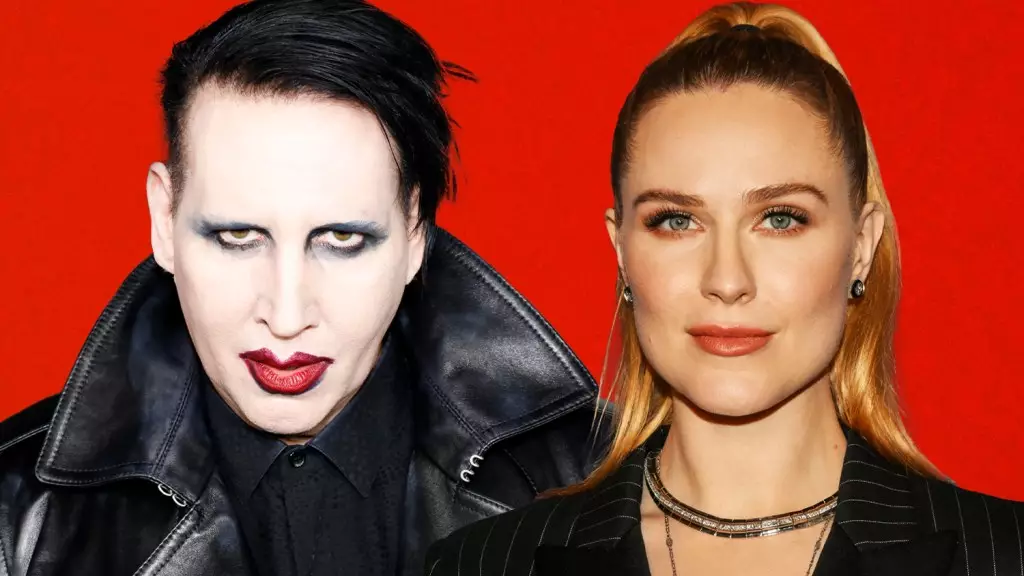In a deeply unsettling revelation aired in the first episode of Channel 4’s documentary series “Marilyn Manson: Unmasked,” actress Evan Rachel Wood opens up about her harrowing experiences with the controversial rock musician, Marilyn Manson. Wood, a prominent figure in the entertainment industry, has previously leveled accusations against Manson, alleging a history of emotional and physical abuse. This latest chapter in their tumultuous saga has only intensified public scrutiny and discussion about consent, trauma, and the responsibilities of artists toward their collaborators.
Wood’s revelations during the documentary are stark and emotionally charged. She describes feeling “violated” and later refers to the incident as tantamount to rape, a term she hesitated to use for many years. This internal conflict regarding the language of trauma is crucial, as it reveals the often convoluted process of recognizing and articulating experiences of abuse, especially in the context of a creative work environment. The documentary poignantly illustrates Wood’s emotional state during the 2007 filming of Manson’s music video for “Heart-Shaped Glasses,” wherein she was led to believe that the boundaries of the shoot would be respected.
The music video project was, according to Wood, initially framed as an artistic endeavor with a certain ambiguity—described to her as similar to “Lolita.” However, the narrative took a shocking, unanticipated turn once filming commenced. Wood recounts how what was supposed to be an abstract representation of intimacy swiftly transitioned into a distressing experience that left her feeling as if she were in a dissociated “dream state.”
When the camera started rolling, Wood describes her recollections vividly, painting a picture of a chaotic scene that contravened the agreed-upon parameters of the shoot. The description of Manson’s aggressive behavior serves not only to illustrate her discomfort but also to shed light on the power dynamics often present in film and music industries, where the creative vision can overshadow the welfare of the individuals involved. Indeed, Wood’s account reinforces a critical conversation about the need for clear communication and established boundaries in creative works, especially when sensitive themes are involved.
In response to Wood’s allegations, Manson’s attorney, Howard King, vehemently denied any wrongdoing. King characterized the claims as “demonstrably false” and emphasized the presence of numerous crew members during the filming. The insistence that Manson was not inappropriately undressed during the alleged incident is, perhaps, an effort to undermine the gravity of the charges made against him. However, this rebuttal raises larger questions about societal perceptions of consent and the complexities of consent in performance spaces.
Historically, allegations of misconduct within the entertainment industry have often led to polarized public responses, as seen in the aftermath of Wood’s accusations. Manson himself had labeled Wood’s claims as “distortions of reality,” a remark that reflects a broader trend of dismissing allegations as “unsubstantiated” when they originate from vulnerable women. This defense appears to trivialize the real impact of trauma and underscores the challenges faced by those coming forward to share their stories.
Wood’s courageous revelation in the documentary serves as a potent reminder of the importance of listening to and validating survivors of abuse. The gravity of her experiences resonates with many who have similarly struggled to reclaim their narratives in the wake of trauma. Furthermore, the ongoing discussions surrounding Wood and Manson’s tumultuous past highlight the systemic issues of power imbalances in creative industries, underscoring the necessity of fostering environments where consent is prioritized and respected.
As the documentary continues to unfold over its three-part series, it invites viewers to engage in a critical discourse surrounding the broader implications of Manson and Wood’s history. The anticipation of further episodes raises questions about the societal change needed to address such painful issues and the importance of empowering individuals to share their experiences with confidence and support.
Evan Rachel Wood’s brave disclosures in “Marilyn Manson: Unmasked” not only provide an eye-opening narrative of personal trauma but also illuminate the complex tapestry of abuse, consent, and accountability within the entertainment industry. As audiences digest these revelations, the imperative for systemic change and heightened awareness becomes clearer, demanding the collective responsibility of both industry peers and society at large.
